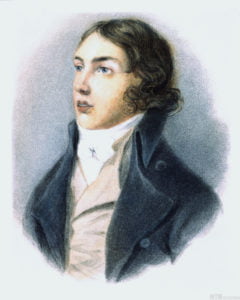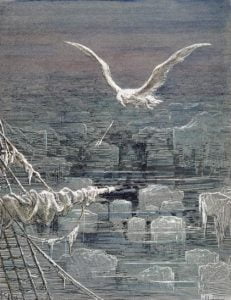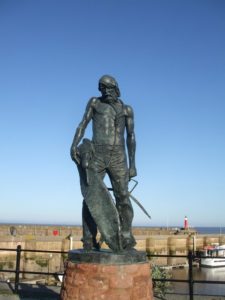Characters & Colours: Coleridge’s Ancient Mariner – His Sin And Atonement

With the birthday of Samuel Taylor Coleridge round the corner on October 21, I obviously got reminded of his most beautiful creation – the vulnerable ancient Mariner who sins and learns by his mistake how to revere Nature in a remarkable way.
Known as one of the longest poems in English literature, The Rime of the Ancient Mariner by Coleridge was published in 1798. The Mariner from Rime of the Ancient Mariner is an unnamed seaman who shoots an albatross. This spells doom for his fellow sailors. Through his glittering eyes, he gains some clairvoyance to know who should need to hear his story in order to develop sensitiveness towards Nature.

(1772-1834). English poet and critic. English aquatint, c1800.
There have been various speculation regarding the origin of the story of Coleridge’s poem. He is likely to have been inspired by a conversation he had with fellow poet William Wordsworth regarding an incident where an albatross was killed in George Shelvocke’s “A Voyage Round the World.” Some say the poem could have been a representation of a dream that George Cruikshank, a friend of Coleridge, saw. Other conjectures point to the possibility of the mariner being Fletcher Christian, who led the HMS Bounty in 1789.
The Mariner in the titular ‘Ancient Mariner’ is unnamed perhaps because Coleridge wanted to focus on the sequence of events in the story. The agent telling the story is nevertheless quite crucial to the story as it is through his eyes that we understand the nature of crime, punishment, atonement and expiation. The Mariner and his sailors at first perceived the albatross to be God-sent in order to save the ship being stuck in the ice-sheets all around:
“The ice was here, the ice was there,
The ice was all around:
It cracked and growled, and roared and howled,
Like noises in a swound!
At length did cross an Albatross,
Through the fog it came;
As if it had been a Christian soul,
We hailed it in God’s name.”
Though at first the albatross was perceived to be a good omen, the mariner shoots it whimsically without citing any real reason for killing the congenial bird which used to eat and play with the sailors often. What lends a mystery to the character of the mariner is he never explains his sudden and violent act. He just reaps the consequences of his sins soon after. Perhaps, Coleridge portrays the reckless behaviour of man towards Nature through the unreasonable and insensitive act of the mariner. Everyone blamed the mariner at first and he realised: “And I had done a hellish thing…” but eventually the sailors convinced themselves it was due to the bird that they saw the fog and the ice which brew all troubles. However, whether the mariner continued to feel guilty after this is not clear from the poem. It is strange how human beings transfer their angst onto Nature is perhaps what Coleridge wants to underscore.

“The bloody Sun” scorched the mariner and his sailors. There was scarcity of water and they saw some ‘slimy things’ crawling in the ‘slimy sea’. Everyone had to pay heavily for the mariner’s sin of killing the albatross:
“Each throat
Was parched, and glazed each eye,
A weary time! A weary time!
How glazed each weary eye”
Even at this juncture, it is not clear if the mariner understands that the suffering and the plight of his fellow sailors is due to his act. But day by day, the situation worsens over which the mariner has no control. Finally, he loses his sailors:
“Four times fifty living men
(And I heard nor sigh nor groan)
With heavy thump, a lifeless lump
They dropped down one by one.
The souls did from their bodies fly-
They fled to bliss or woe
And every soul, it passes me by,
Like the whizz of my cross-bow!
Through the action of the mariner and the plight of the sailors, Coleridge shows the Hindu theory of Karma. No one can escape the consequences of their reckless actions. His ‘soul in agony’, the mariner continued to live in torment watching (his dead sailors) ‘curse in a dead man’s eye’. The worse punishment for the mariner was he could not live nor could he die. It was a torture to witness the sight of the slimy creatures in the rotting environment and the corpses for seven days and seven nights. Only when the mariner blesses the silver snakes in his heart does the situation change: there is rain, his sailors come to life and everything is restored back to a better situation, though not the best because of the mariner’s guilt nursing his heart.

“The Ancient Mariner” (1925) is a silent film adaptation on the poem. Another adaptation was a film by Raul da Silva in 1975. In 1977, a short film on the poem was made by Larry Jordan – this is a popular adaptation in which Orson Welles gives the voiceover. Powerslave band used a song featuring The Rime of the Ancient Mariner. Some video games have also been based on this most famous poem of Coleridge.

Comments are closed.